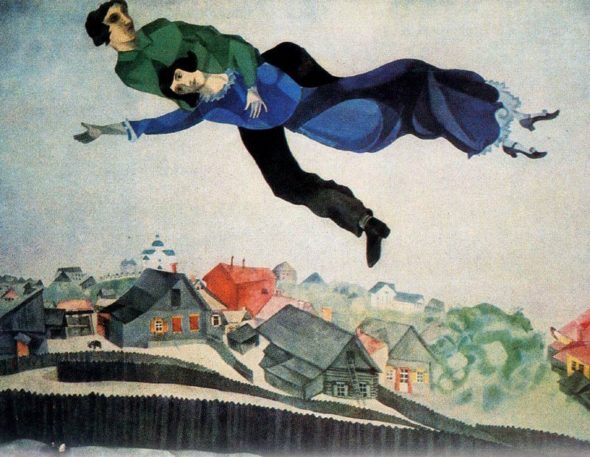

Marc Chagall, "Over the Town," 1918. (Via Wikiart.org)
BLOG— The rule of love
- Published: February 13, 2018
When I was six — and eight, and 10, but never again after then — I made valentines for everybody in my class. Everybody did. The rule was that you liked everybody, even those you suspected you didn’t like. The weird boy with clammy hands and anarchic feet who was, by a freak of height and fate, your square dancing partner for the eternity of fourth grade? Him, too.
The elementary-school rule was that everybody was your friend, an impossible ideal, yet five simple materials miraculously made it so: paper, scissors, markers, doilies, glue. With those five materials — plus a sixth, glitter, if your mother allowed it — you cranked out identical valentines for every kid. “To Mike,” or Kevin, or Jenny, you wrote at the top. “From Your Friend,” you wrote at the bottom, signing your name.
How different the rule of love that holds sway at Valentine’s Day as an adult. It’s a rule of exclusivity, of choosing and rewarding the few objects, maybe the sole object, of your affection. Love is not meted out fairly, universally. We believe it’s in the nature of love, that it is love, to choose, to discriminate.
Erich Fromm, in his complex 1956 book on the subject, “The Art of Loving,” offers a different view, rooted in paradox. Love has one premise, he writes. “That I love from the essence of my being — and experience the other person in the essence of his or her being.” At the level of essence, he continues, all people are identical. “This being so, it should not make any difference whom we love.”
Pause there a moment. It should not make any difference whom we love. That’s not quite the candy-heart message of love. Be Mine. All Mine. My Boy. My Girl. Love, as celebrated in the culture and especially on this holiday, is premised instead on the singularity of the beloved, defined often in terms of the singularity of the bond between the beloved and you.
But Fromm goes on. In practice, he concedes, whom we love does make a difference. We’re a little more selective, most of us. And that’s because the opposite of essence is also true. “We are all One — yet every one of us is a unique, unduplicable entity.” We are One and we are one. And love, the most human of acts, navigates that most human of paradoxes.
Yet not always very well. Fromm elsewhere in the book suggests that our concepts of love, and thus our actions taken in the name of love, tilt toward its “unique, unduplicable” aspects and away from its essence. When the beloved gratifies, we call it love. When the beloved frustrates, we call it, maybe, quits. When we fail to relate to the One in the one, we love too little, too lightly. Too easily and without, in the end, the full beauty, which is also the full difficulty, of love.
Which brings me back to childhood valentines. True, I didn’t like everybody. True, everybody didn’t like me. And being children, we found subtle ways to subvert the grown-ups’ vision of universal love, adding a tiny heart over the “i” of “friend” on certain valentines, for example: a subtle signal of preference, a hairsplitting hierarchy of affection where more open divisions of loyalty were disallowed. But that rule: everybody was your friend. I can’t help thinking it’s a good one.
Right now, as our world and perhaps our very hearts are breaking apart, I’m longing to make valentines for every person on earth. I’m longing to shake a very big bottle of glitter onto 7.6 billion identical cut-out red paper hearts. I’m longing to sign them, “Your Friend.” And most of all, I’m longing to practice the art of meaning it.
The Yellow Springs News encourages respectful discussion of this article.
You must login to post a comment.
Don't have a login? Register for a free YSNews.com account.













No comments yet for this article.